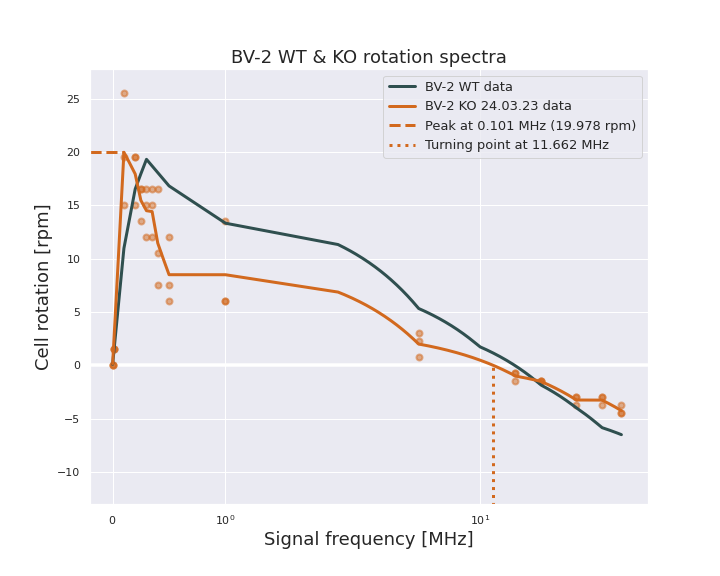24.03.23
From mn.fysikk.laglivlab
Present: Nigar, Lasse, Morten
Plan for the lab: passaging BV-2 cells (KO and WT), and performing first rotation with KO cells
Results (rotations per 10sec):[edit | edit source]
Each row for a clip is a different cell.
| 10kHz | 100kHz | 200kHz | 250kHz | 300kHz | 350kHz | 400kHz | 500kHz | 1MHz | 5Mhz | 15MHz | 20MHz | 30MHz | 40MHz | 50MHz |
|---|---|---|---|---|---|---|---|---|---|---|---|---|---|---|
| 0.25 | 4.25 | 3.25 | 2.75 | 2.75 | 2.75 | 1.75 | 2 | 1 | 0.375 | -0.125 | -0.25 | -0.625 | -0.5 | -0.75 |
| 0.25 | 2.5 | 2.5 | 2.75 | 2.5 | 2 | 2.75 | 1 | 1 | 0.125 | -0.25 | -0.25 | -0.5 | -0.5 | -0.625 |
| 0.25 | 3.25 | 3.25 | 2.25 | 2 | 2.5 | 1.25 | 1.25 | 2.25 | 0.5 | -0.125 | -0.25 | -0.5 | -0.625 | -0.75 |
Observations:
- higher rpm at peak, possibly in the similar frequency range
- earlier turning point - cells slowed down earlier than WT: were almost stationary at 10MHz
- larger amount of cell lysis
- high density of cells : used 2ml og cells instead of 1ml as usual (used 0.5ml for WT on Wednesday, but this is also because the confluency was different)
Observations after plotting:
- Most cells were disturbed by close neighbour cells, but we tried to pick out more isolated and undisturbed cells
- The KO spectra appears very distinct from our WT control spectra (see 22.03.23), very promising start! :D
- Considering that the KO cells are significantly larger than the WT we used, it could be reasonable that that the area under the curve (thus rotational velocity) is lower. Larger surface area means more friction with the supsension media, which may also make it struggle more with keeping up with the field frequency (thus earlier turning point).
- More experiments should be performed with the KO cells to confirm this data. If those results are similar we should have proof of the viability of electrorotation in distinguishing the mutated and healthy cells!
